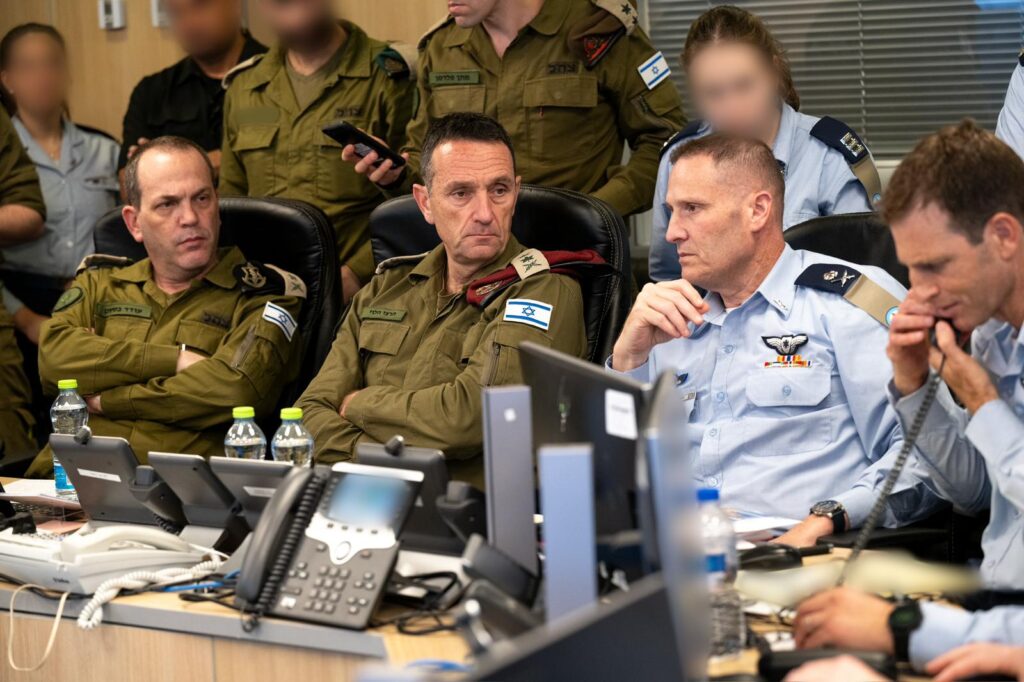Unprecedented Iranian attacks on Israel
- In recent decades, Iran has embarked on an aggressive policy of expanding its influence across the Middle East, with a key aim of encircling Israel. This has involved the funding of proxies, armed militias and terrorist groups across the region, Iran’s “axis of resistance”.
- Iran has been attacking Israel since October through terrorist proxies in Syria, Yemen, Iraq and Hezbollah in Lebanon. 80,000 Israelis from the north of the country are still internally displaced because of daily attacks from Lebanon and Syria.
- 13 April however marked a distinct shift in the nature of Iran’s attacks. The Islamic Revolutionary Guards launched an unprecedented attack directly onto Israeli territory. Iran is the first sovereign state to attack Israel since Saddam Hussein’s Iraq in 1991.
- It came after an Israeli strike against Islamic Revolutionary Guards Corps (IRGC) members in Damascus a fortnight ago, which killed Brig. Gen. Mohammad Reza Zahedi, the most senior IRGC officer to be killed since the US assassinated IRGC chief General QasemSoleimani in 2020.
- The Iranian attack consisted of 30 cruise missiles and 120 ballistic missiles, as well as 170 ‘shahed’ drones which have been used by the Russians, with devastating consequences, in their attack on Ukraine.
Israeli defence
- The attack had the potential to inflict thousands of civilian casualties, Israel’s ability to intercept and thwart the Iranian attack, preventing any loss of life, is testament to its “multi-layered” system of missile defences.
- There was a serious injury to Amina al-Hassouni, a seven-year-old Bedouin girl, when shrapnel from an Iranian missile struck her family home. She has had two surgeries and is in critical condition.
- International support by international allies, including the US, UK, France and other Arab countries was integral to Israel’s defence. The initial swarm of suicide drones, and then later ballistic and cruise missiles fired from Iran, Iraq and Yemen were spotted by forward bases near Iran by the US military’s Central Command. A coalition of western and Arab forces then scrambled fighter jets to intercept Iranian missiles.
- None of the 170 ‘shahed’ drones penetrated Israeli airspace and 25 of the 30 cruise missiles were shot down by Israeli jets. The missiles that did get through the initial interception were impacted by widespread and deliberate jamming of the GPS signal.
- The Israeli Aerial Defense Array used the Iron Dome and David’s Sling systems which can and did intercept medium to short distance attacks. The arrow system was most effective at countering Iranian long range missiles.
- Rishi Sunak confirmed on Sunday that RAF pilots shot down several Iranian attack drones and helped save lives “not just in Israel, but in neighbouring countries such as Jordan as well”. He said that had the attack been successful, “the fallout for regional stability would be hard to overstate”.
The Israeli response and allies’ advice
- Israeli war cabinet member Benny Gantz cited the need to “build a regional coalition and exact a price from Iran, in a way and at a time that suits us” seemingly indicating that he does not support immediate retaliation against Iran itself. He spoke about the world’s support for Israel: “Israel versus Iran, the world versus Iran. This is the result.”
- On 15 April, Israeli military chief of staff Herzi Halevi said that “this launch of so many missiles, cruise missiles and drones into Israeli territory will be met with a response” but gave no details.
- Israel is being urged by its western allies to de-escalate the situation. Joe Biden reportedly told Netanyahu that “You got a win. Take the win.” The G7 convened on 14 April, condemning Iran’s attack against Israel and reaffirming the group’s commitment to Israel’s security.
- On 17 April Netanyahu met with foreign secretary David Cameron who told him that “it’s in no one’s interest that we see escalation and that is what we said very clearly to all the people I’ve been speaking to here in Israel.”
- Following the meeting, Netanyahu said: “I want to make it clear – we will make our own decisions, and the State of Israel will do everything necessary to defend itself.”
Hamas an ‘obstacle’ to Gaza ceasefire.
- Hamas have rejected a series of ceasefire deals that Israel, the US, Egypt and Qatar have jointly proposed in the last few months.
- On 14 April, Hamas rejected another ceasefire deal. This proposal was widely reported to offer a ceasefire of several weeks in return for the release of dozens of hostages. Israel would also boost aid to Gaza and release hundreds of Palestinian security prisoners held in its jails, including a considerable number of prisoners convicted of murders. On 15 April, the US accused Hamas of being the barrier to a temporary in ceasefire in Gaza, adding that Israel had moved in a “significant” way” to submit a reasonable proposal in the ongoing hostage talks.
- A fortnight ago, Hamas claimed it does not have 40 living hostages from the category of women, children, elderly men and female soldiers. Israel asked that the Hamas make up the 40 with men under the age of 50 still being held as hostages.
- Israeli officials say Hamas is only wiling to release 20 hostages who are women, men over 50, or are sick.
- There have been conflicting reports on whether Israel has set a date for an operation in Rafah. On 8 April, defence minister Yoav Gallant told his US counterpart Lloyd Austin that Israel has not set a date for the launch of a major ground offensive in Rafah, despite statements from Benjamin Netanyahu, who claimed a date had been set.
- As the humanitarian situation worsens in Gaza, Israel has promised to “flood” the Gaza Strip with aid from a variety of entry points, the IDF chief spokesman Daniel Hagari told foreign reporters a fortnight ago.
- Biden announced that in the 12 days following his call with Netanyahu, 3,000 trucks with food and supplies moved into Gaza – a daily increase of over 50% from the week prior. He added that this was, however, “still not enough”.
Looking forward
- The Mitvim Institute and the Berl Katznelson Center have created the Israeli Initiativeaiming to turn the tragedy of October 7th and the ensuing war into a political turning point between Israel, the Palestinians, and the Arab World.
- The paper recognises that Israel is at a crossroads waiting to take one of two paths, the first of the right wing and Netanyahu’s desire for perpetual conflict and the second being led by the democratic camp ensuring Israel’s security and existence as an egalitarian, Jewish and democratic state.
- It sets out a 3-to-5-year roadmap comprised of three phases that offers a political horizon of a demilitarised Palestinian state and the foundation of a US-led regional alliance of moderates.
- The starting phase will see a transition from war to political action. Followed by a transitional phase preparing the ground for a Israeli-Palestinian peace process. This will see Gaza rebuilt and the PA renewed. The final, negotiating phase will promote the creation of a stable settlement.
- Israel will advance an exit strategy from the war in the opening phase while defining a political vision. It will involve:
- An international peace conference, linking Hamas’ defeat with increasing stabilisation, demilitarisation and rehabilitation of the Gaza strip. It will also promote the vision of a future demilitarised Palestinian state.
- International-regional framework, replacing the old quartet with the US, EU and leading Arab states.
- Commitments: Israel will declare its willingness to strengthen the PA and the Palestinians will declare the 1967 territories (Gaza and the West Bank) as the future Palestinian state while recognising Israel is a sovereign state. They will also declare an abandonment of terrorism.



